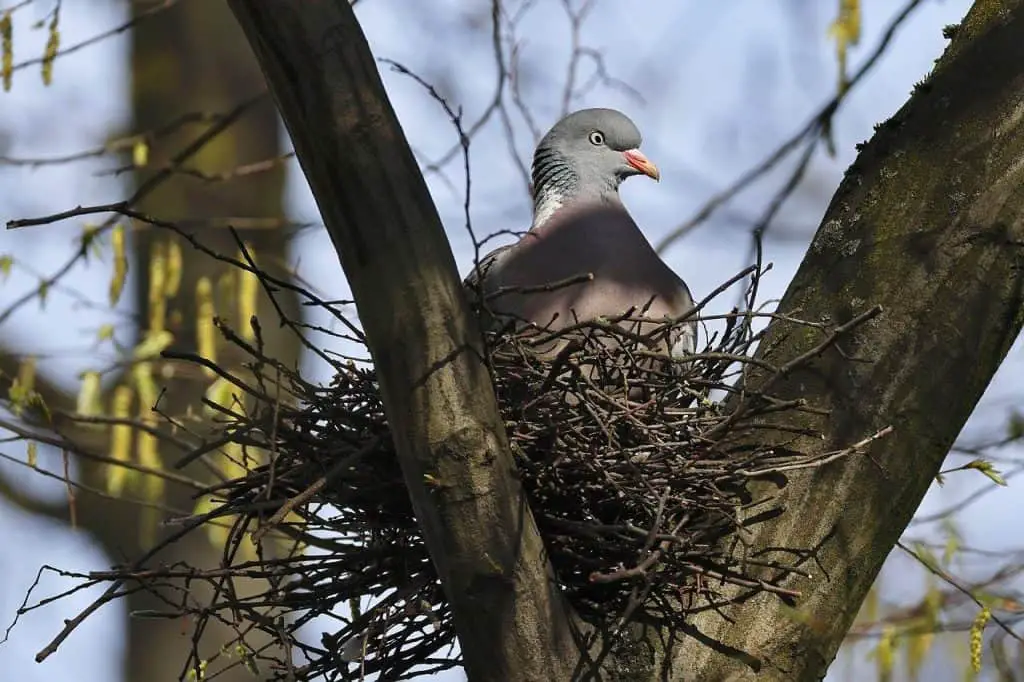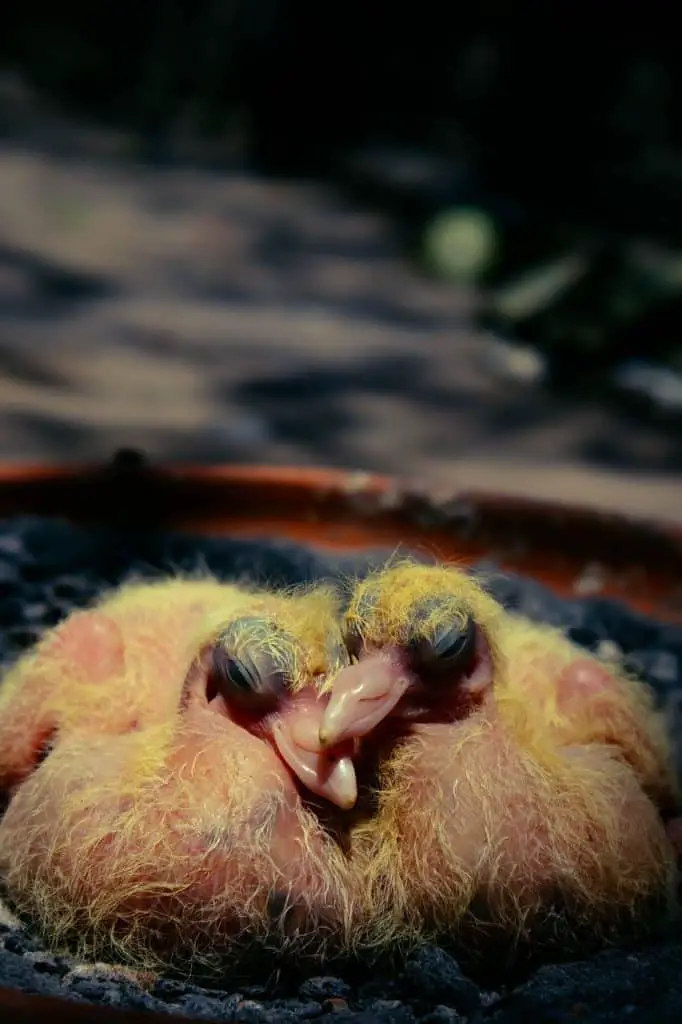Pigeons represent one type of animal that many humans come in close contact with every single day. And one of the most interesting facts about any type of bird is their nesting behavior. The same holds true for pigeon nesting behaviors.
Since these critters tend to dwell near humans, it’s natural to be curious about their behaviors. That’s especially true if you’ve spotted a pigeon nest nearby. Let’s explore everything you need to know about pigeons in nests.
Key facts
- Pigeons nest in a wide range of habitats. Everything from cliffs and skyscrapers to bushes and trees is fair game.
- The common birds tend to lay one or two eggs in their nest, which they may reuse multiple times in a single year.
Pigeon Nesting Habits

While you’ve likely seen a pigeon, or possibly thousands of these common birds, it’s possible you’ve never spotted a nest. The birds are comfortable nesting in a wide range of locations, which increases your chances of happening upon a happy pigeon nest.
Pigeon Nesting Locations
Pigeons, known for their adaptability and resilience, exhibit diverse nesting locations depending on their environment. In urban areas, pigeons often choose man-made structures as their preferred nesting sites. Building ledges, window sills, and rooftop corners provide sheltered spots where pigeons can build their nests out of twigs, leaves, and other materials they scavenge from their surroundings. These elevated locations offer a sense of security and protection from ground predators.
In contrast, rural areas provide pigeons with a range of natural nesting options. Trees and forests are common sites for pigeon nests, offering sturdy branches for support and camouflage amidst the foliage. In more rugged landscapes, pigeons may utilize cliffs and rock outcrops as nesting sites, taking advantage of the sheltered crevices and ledges they provide. Ground nesting is also observed in some pigeon species, where they create shallow nests on the ground, often nestled within grassy areas or under shrubs.
The diverse selection of nesting locations reflects pigeons’ ability to adapt to various habitats, whether it be in bustling cities or serene natural environments.
If you are on a road trip, you might be able to find pigeons nesting everywhere from the most isolated areas to the streets of a bustling city.
Materials Used in Pigeon Nests
Pigeons are resourceful nest builders, utilizing a combination of natural and human-made materials to construct their nests. They actively gather twigs, branches, and dried grass from their surroundings, diligently arranging them into a sturdy foundation. These natural materials provide structure and stability to the nest, ensuring it can withstand the elements.
In addition to natural materials, pigeons also incorporate human-made materials into their nests, particularly in urban environments. They actively seek out urban debris, such as bits of string, cloth, and discarded materials to supplement their nest-building efforts. Feathers and fur, whether collected from their own bodies or from other animals, are also incorporated into the nest, adding insulation and softness.
By actively selecting and arranging these materials, pigeons create a comfortable and secure environment for their eggs and nestlings. The use of both natural and human-made materials highlights their adaptability and resourcefulness in adapting to their surroundings.
Pigeon Mating Behavior
Pigeons engage in intricate courtship rituals. Males actively compete for the attention of females by puffing out their chests, cooing, and bowing in an elaborate display. They may also engage in aerial acrobatics, showcasing their flying skills and agility.
Once a male successfully attracts a female, they engage in a series of bonding behaviors. They engage in mutual preening, where they groom each other’s feathers, reinforcing their bond and establishing trust. Males also present nesting materials to females as a form of courtship, demonstrating their ability to provide for the nest.
Once the pair forms a strong bond, they proceed to copulation, which is a quick and efficient process. Pigeons often mate multiple times within a breeding season to maximize the chances of successful fertilization.
Pigeon Chick Rearing Choices

In general, female pigeons lay either one or two eggs. Depending on the success of the brood, they might lay one to three more clutches (batches) of eggs in a single year.
Once the female lays her eggs, both parents take turns incubating them, actively regulating the temperature and ensuring their safety. This shared responsibility allows for efficient incubation and ensures the eggs have the best chance of hatching.
After the eggs hatch, the parents diligently care for their nestlings. They provide them with regurgitated crop milk, a specialized secretion rich in nutrients, to nourish and promote their growth. The parents also keep the nest clean by removing waste and protecting the chicks from potential predators.
As the nestlings grow, they develop feathers and become more active. The parents continue to feed them and encourage their fledging. Eventually, the young pigeons gain enough strength and coordination to leave the nest and explore their surroundings.
When Do Pigeons Nest?
Pigeons are opportunistic nesters and their nesting timing can vary depending on factors such as food availability, weather conditions, and breeding cycles. In general, pigeons tend to breed during the spring and summer months when food resources are abundant and temperatures are favorable for nesting.
The exact timing of pigeon nesting can vary across regions and species. Some pigeons may start nesting as early as late winter or early spring, while others may begin later in the spring or early summer. It is during this time that pigeons engage in courtship displays, select nesting sites, and begin building their nests.
Pigeons often raise multiple broods in a breeding season, allowing them to maximize their reproductive success. This means that after successfully fledging one brood, pigeons may proceed to lay another clutch of eggs and start the nesting process again.
Will Pigeons Reuse A Nest?
Pigeons are known to reuse their nests if they are undisturbed. After successfully raising a brood and fledging their chicks, pigeons may choose to reinforce or repair their nest for future breeding cycles. This behavior allows them to save time and energy by utilizing an existing structure rather than building a new nest from scratch.
What to do if You Find a Pigeon Nest
If you find a pigeon nest intact, with baby birds inside, please give the nest plenty of space. It’s best to leave the nest undisturbed and allow the parents to care for their young.
If you find a baby pigeon that appears to be abandoned or in need of assistance, it’s important to proceed with caution and consider the best course of action. First, assess the situation and determine if the chick is truly in distress or in immediate danger. If the chick is uninjured and appears healthy, it may not require immediate intervention.
In some cases, the best approach is to monitor the baby pigeon from a distance and observe if the parent pigeons are caring for it. Pigeon parents are attentive and dedicated, and they may be nearby, watching over their chick and providing necessary care. If the parent pigeons are present and actively caring for the chick, it’s generally best to allow them to continue their natural parenting behaviors without interference.
However, if the baby pigeon is clearly injured, in a dangerous location, or the parent pigeons are absent for an extended period, it may be appropriate to contact a local wildlife rehabilitation center or a licensed wildlife rehabilitator. These professionals have the expertise to assess the situation, provide appropriate care, and make necessary decisions for the well-being of the baby pigeon. It’s essential to avoid attempting to care for or raise a baby pigeon without proper knowledge and experience, as their specialized needs can be challenging to meet without professional guidance.
Pigeons Nesting: Frequently Asked Questions
You have questions about pigeons nesting. I have answers.
Where do pigeons typically build their nests?
Pigeons are adaptable birds and can build nests in various locations. Common nesting sites include building ledges, window sills, trees, cliffs, and even on the ground.
How long does it take for pigeons to build their nests?
The time required for nest building can vary depending on factors like the availability of materials and the level of competition for nesting sites. Typically, pigeons can construct their nests within a few days to a couple of weeks.
Are there any challenges associated with pigeon nesting?
Pigeon nesting can present challenges, particularly in urban environments. Issues such as overpopulation, health concerns, and damage to structures may arise. Implementing management strategies, such as nest removal, sterilization programs, and habitat modification, can help address these challenges.
Final Take on Pigeons Nesting
Nesting pigeons are often an adorable sight to behold. While many pigeons live in close proximity to humans, they are still wild creatures that have shown a remarkable tenacity and willingness to adapt to their changing world.
